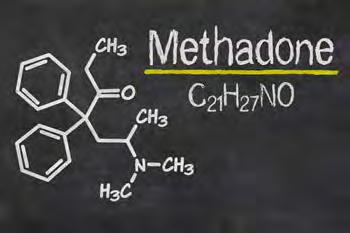
1 minute read
Methadone
Jilian Banzon, 3rd year Professional Student, Fall 2022
History/Background
Advertisement
Methadone is a medication approved by the Food and Drug Administration (FDA) to treat Opioid Use Disorder (OUD) as a medication-assisted treatment (MAT), as well as for pain management. Methadone's origin started when German scientists wanted to develop a drug to help avoid opiate withdrawal due to the opium supply being cut off in World War 2.As a result, methadone was synthesized and the drug not only worked, but also lasted a long time.
https:// americanaddictioncenters.org/ wp-content/uploads/2018/10/ how-long-does-methadone-stayin-your-system.jpg
Slang terms/Street names
Methadone goes by numerous slang terms or street names and on streets it is commonly referred to as Amidone, chocolate chip cookies, fizzies, Maria, pastora, Salvia, street methadone and water.

https://img.medscape.com/ thumbnail_library/gty_220713 _opiods_methadone_syringe_800x450.jpg

Pharmacology/drug effects
Methadone is a synthetic full agonist at the m-opioid receptor. It has an asymmetric carbon atom, and the racemic mixture is generally used in maintenance therapy. When a user takes methadone they use it for detoxification and maintenance of opioid addiction and as a pain reliever for moderate to severe pain. When someone uses methadone they can experience physical symptoms like sweating, itchy skin, or sleepiness. When use is stopped, individuals may experience withdrawal symptoms including Anxiety, muscle tremors, nausea, diarrhea, vomiting, and abdominal cramps.
https://s3.wp.wsu.edu/uploads/ sites/2797/2021/1 0/ iStock-503756218_wp.jpg

Drug interactions/Toxicology
https:// janaburson.files.wordpress.com /201 4/03/aaaapilsfighting.jpg https://t4.ftcdn.net/
People who use methadone at high doses, or in naïve users or idiosyncratically at much lower doses, depresses respiration and may interfere with cardiac function, either or both of which can lead to death. Methadone is a central nervous system (CNS) depressant, and there is a very high risk of negative complications when it is combined with other depressants such as alcohol and benzodiazepines.
Methadone is a Schedule II drug under the Controlled Substances Act. While it may legally be used under a doctor’s supervision, its non-medical use is illegal. It is considered a schedule II drug due to its high potentially addictive qualities. Methadone is a highly regulated drug and while it has medicinal purposes the fact that it is a powerful opiate is the reason why it is highly regulated when used as a medical treatment for opioid use disorder.
Monitoring/drug screens

https://cdn.jjkeller.com/wcsstore/
Since methadone is a highly regulated drug, patients who are prescribed Methadone in an outpatient setting have to go to a clinic every day to be administered their dose. After a period of stability, patients may be allowed to take methadone at home between program visits. Patients on methadone must also be on the drug for a minimum of 12 months. Methadone is not usually screened for on a urine drug test unless otherwise specifically requested.








